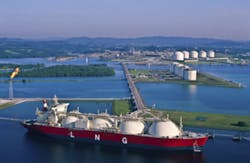GE hosted a press event at the Offshore Technology Conference this week in Houston to highlight key aspects of its newly formed Marine business unit and its overall strategy for servicing the oil and gas market. GE Marine was formed in early 2015 with the aim of bringing together GE's commercial and technological expertise from several GE businesses to serve the oil & gas marine segment. Tim Schweikert, vice president of GE Marine, says the formation of this new business unit was the product of a desire among GE's customer base to have a single point of contact for developing solutions for offshore oil and gas applications.
Schweikert says GE currently has 1,400 vessel references in the marine oil and gas space, and GE Marine's focus is on helping these customers in the areas of Power (diesel engines, gas & steam turbines, generators, switchgear, transformers, motors, pumps, compressors and turboexpanders), Propulsion (podded propulsion, propulsion motors, variable speed drives), and Positioning (vessel automation and control systems, dynamic positioning systems, sensors, flowmeters, valves, and condition monitoring). Schweikert says GE's expertise as a manufacturer of equipment used in marine oil and gas environments, combined with its capability in the area of data analytics and control systems, helps inform its solutions for marine oil & gas in a way that gives it a competitive edge in the marketplace.
Among the key elements of GE's push in the marine space is an emphasis on data analytics and utilization. Jeremiah Stone, general manager of GE's Industrial Data Intelligence unit, says many of the equipment-level data feeds in the marine oil & gas segment are not yet connected. As such, he says GE has launched a "Get Connected" program that is designed to help bring devices and equpment online to facilitate data analytics for positive business outcomes.
READ ALSO: GE & Kemira Partner to Bring Water Technology to the Pulp & Paper Industry
However, as more and more devices are feeding data into control systems, the challenge is to develop a system of analytics that enables efficient decision making to strategically inform the business. "When you think about data analytics, the key question is what problem are you trying to solve," says Ashley Haynes-Gaspar, general manager of software and services for GE Measurement & Control. "You can take the approach of what problems could we go solve or what problems should we go solve." She says GE is taking a more targeted approach with the aim of helping its customers prioritize its data strategy in a way that makes the most sense for the overall business.
Along this line, Haynes-Gaspar says there are three key steps organizations must take to effectively leverage data analytics. Step 1 is to figure out the problem that needs to be solved; Step 2 is to identify the available data to help inform the solution to the problem; and Step 3 is to develop a culture of empowerment among the operators so they are taking the appropriate action based on the available data analytics.
In the oil & gas segment, Haynes-Gaspar says oil recovery rates are currently in the 35-40 percent range, and just a 1 percent gain would mean 80 billion barrels of oil or the equivalent of a three-year global supply. GE believes data analytics provide a tremendous opportunity to improve oil recovery rates and drive efficiencies in the oil & gas space overall.
As part of its push at this year's OTC show, GE also made some product and partnership announcements, including:
- Black and Veatch has ordered four compression trains with PGT25+G4 drivers for natural gas liquefaction, for Golar LNG's recently announced Hilli FLNG coversion project. The Golar FLNG vessel project involves the conversion of a former LNG carrier, the Hilli, to a floating liquefaction vessel.
- GE Oil & Gas announced the release of InspectionWorks Connect, a remote collaboration software platform for the nondestructive testing and inspection industry. It provides real-time access to live inspection video and data form anywhere in the world with the aim of enabling faster decision-making for asset reliability.
- GE introduced a new range of wax inhibitors designed to help oil and gas producers ensure uninterrupted flow of crude oil. The ProSolv Wax Inhibitor is designed to provide a consistent flow of hydrocarbon streams from the reservoir to the point of sale.
- GE introduced a corrosion inhibitor designed to help protect crude oil and gas pipelines against the corrosive nature of acid gases. The hydrocarbon-soluble corrosion inhibitor supports sweet, sour, wet, and dry gases.
- GE announced a new water treatment technology for the upstream oil and gas market. GE's new seawater sulfate removal nanofiltration membrane is designed to eliminate nearly all sulfate from injection water in offshore oil production.
Matt Migliore is the director of content for Flow Control magazine and FlowControlNetwork.com. He has covered technology and industry for 12-plus years. Matt can be reached at 610 828-1711 or [email protected].


